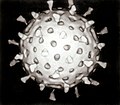| Bombali ebolavirus | |
|---|---|
| Virus classification | |
| (unranked): | Virus |
| Realm: | Riboviria |
| Kingdom: | Orthornavirae |
| Phylum: | Negarnaviricota |
| Class: | Monjiviricetes |
| Order: | Mononegavirales |
| Family: | Filoviridae |
| Genus: | Ebolavirus |
| Species: | Bombali ebolavirus |
| Synonyms | |
| |
Bombali ebolavirus or Bombali virus (BOMV) [1] is a species of the genus Ebolavirus, first reported on 27 July 2018. [2] It was discovered and sequenced by a PREDICT research team from the U.S. in the Bombali area in the north of Sierra Leone, west Africa. [3] [4] The virus was found in the Angolan free-tailed bat and the Little free-tailed bat. [5]
Contents
In 2019, the virus was demonstrated in Angolan free-tailed bats in southeast Kenya and southeast Guinea. [6] [7] Bombali ebolavirus has the capacity to infect human cells, although it has not yet been shown to be pathogenic. [8] [9]
The team reporting the virus also published its full genome sequence (NC_039345). [10]
